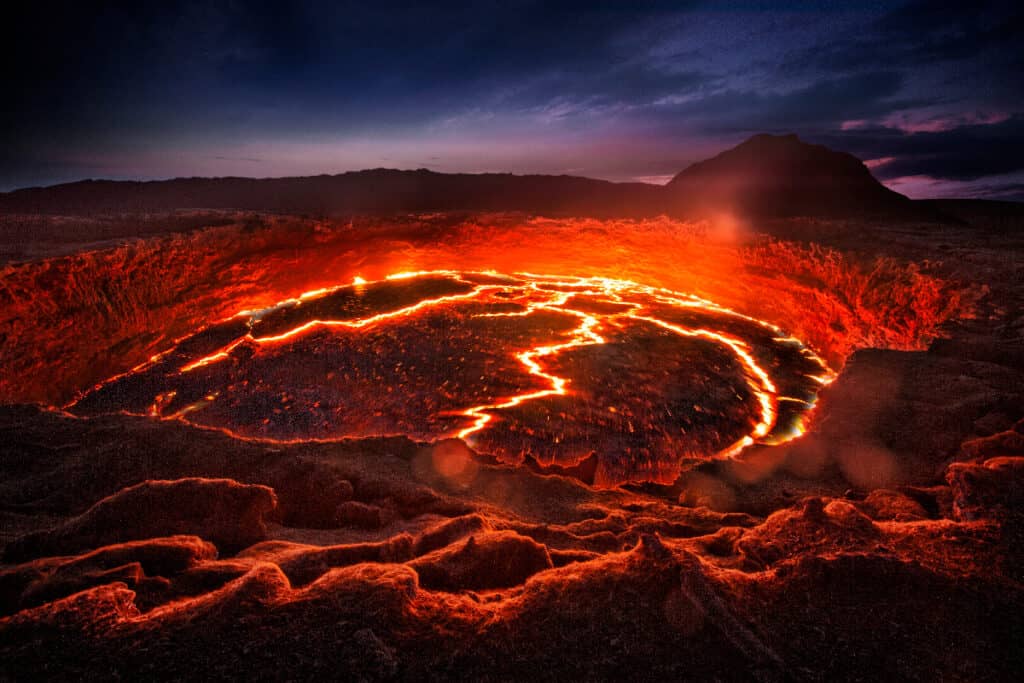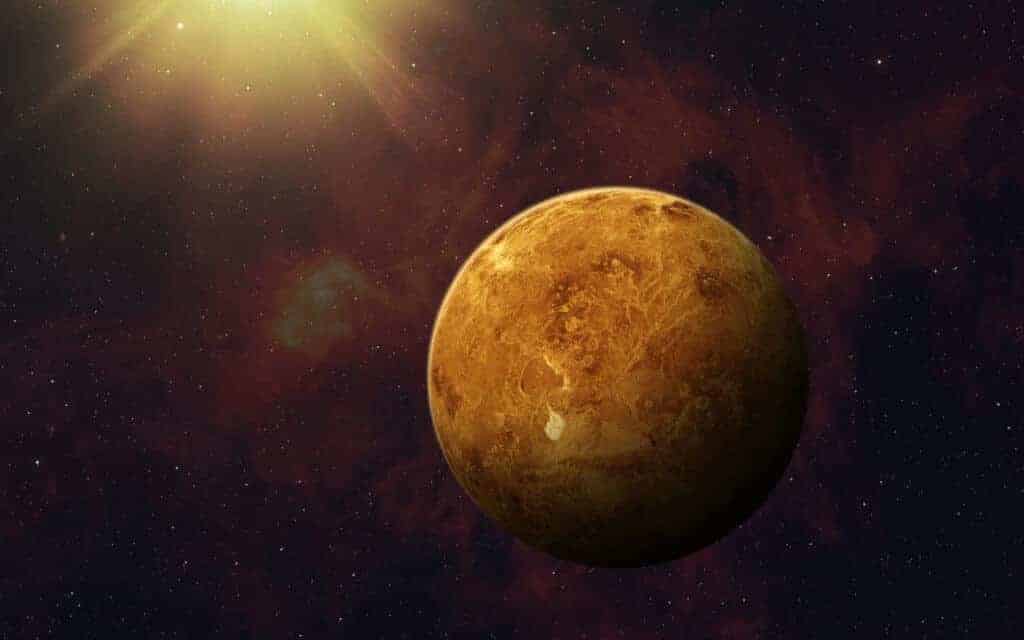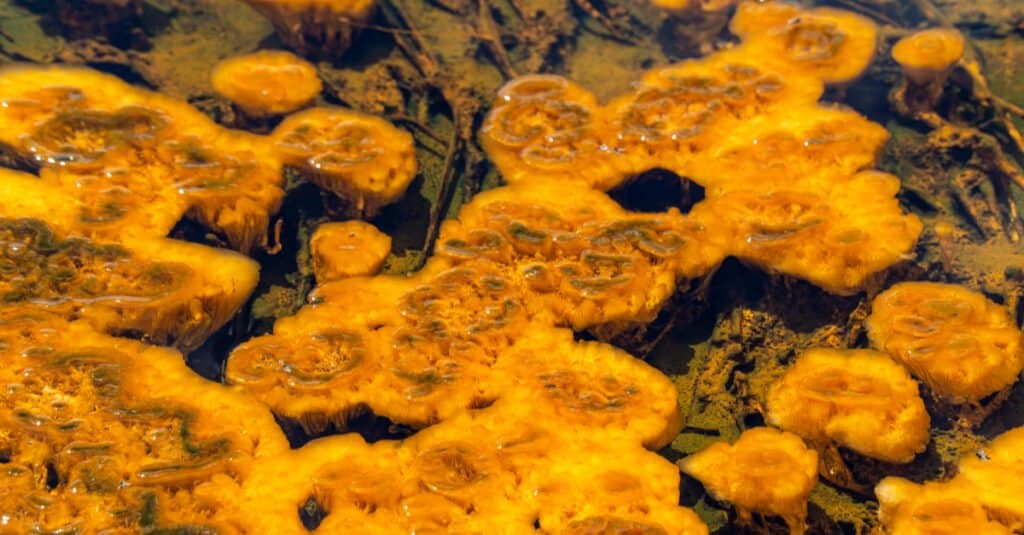With our modern telescopes and space probes, we’ve learned a ton about our neighboring planets, like Venus. However, swarms of information can overshadow simple facts that we would otherwise find fascinating. For example, did you know that space agencies commonly depict planets in different colors or with their atmospheres stripped away? They do this to highlight different aspects of the planet, or just for aesthetic reasons. In the end, we’re left wondering: what is the real color of Venus? What would it look like if we actually visited it and saw it with our own eyes? This article clears up that mystery, along with a few others, such as whether life could exist there, now, or in the future.

In this photo, Venus’ atmosphere has been stripped away and geologic features are color enhanced.
©iStock.com/3quarks
The Atmosphere of Venus
The color of Venus, as seen from space, is determined by the chemical composition of its atmosphere. It’s made up of 96.5% carbon dioxide and 3.5% nitrogen. There are also sulfuric acid clouds in the atmosphere, probably resulting from volcanic eruptions. These chemicals mean Venus is a light yellowish color.
The atmosphere doesn’t just affect the planet’s color. It creates hellish conditions on the surface as well. Carbon dioxide is a greenhouse gas that allows the heat of the Sun to penetrate. However, it also holds in this heat and doesn’t allow it to escape back into space. As a result, the temperature of Venus at its surface is 867 °F. And the pressure of the atmosphere at the surface is 92% higher than it is on Earth. These high temperatures and pressures cause atmospheric gasses to reach a supercritical state. The distinction between gas and liquid starts to break down. Space probes that land on the planet’s surface are designed to withstand temperatures and pressures that can melt lead. In fact, the longest any space probe has been able to survive Venus’ conditions has been about three hours.

The thick carbon dioxide, nitrogen, and sulfuric acid atmosphere of Venus gives it a yellowish tint.
©Artsiom P/Shutterstock.com
What’s Venus Like Under the Clouds?
Venus is one of four terrestrial, or rocky, planets, along with Mercury, Earth, and Mars. Its surface is like our Moon, with some parts rugged and other parts smooth, vast plains due to past volcanic lava. Volcanoes have covered 80% of the surface with these plains. Venus also has a couple of highlands referred to as “continents.” The one in the northern hemisphere is the size of Australia and the one in the southern hemisphere is as big as South America. Researchers think the planet has a similar structure to Earth, with a core, mantle, and crust. But the crust is likely thicker and stronger so there are no plate tectonics on Venus. Additionally, the planet’s interior heat mainly stays trapped inside. Gravity on Venus is about 91% as strong as Earth’s gravity, so your weight would be 9% lower if you stepped on a scale there. For example, a 100-pound person would way only 91 pounds there.

Volcanoes on Venus have resurfaced about 80% of the planet into smooth plains.
©/Shutterstock.com
Is There Water on Venus?
Venus may have had water in the past, but it has no appreciable amounts of water today. If, like the Earth, it had large oceans, these have long since boiled away. Perhaps large volcanic eruptions released greenhouse gasses into the atmosphere and got a runaway greenhouse effect going. The water boiled away into steam and rose into the atmosphere. Sunlight broke down the water molecules and released the hydrogen into space to be swept away by the solar wind.

As temperatures on Venus rose to the boiling point of water, oceans evaporated, leaving behind a desert.
©buradaki/Shutterstock.com
Could Life Exist on Venus?
Even though the conditions are so harsh and waterless on Venus, some researchers think unusual forms of life might be able to thrive in its atmosphere. On Earth, we have thermophiles, which are forms of bacterial life that live in the intense heat and pressure around undersea volcanic vents or hot springs. At the higher levels of the atmosphere of Venus, temperatures and pressures are not as great as that endured by thermophiles on Earth. However, any thermophiles that naturally occurred on Venus would be very different from those on Earth, because they would have to exist in a water-free environment and would have to float in the atmosphere permanently without coming to rest on any solid surface.

Thermophiles can exist at temperatures, pressures, and compositions that would kill other lifeforms.
©GeoNtoH/Shutterstock.com
Terraforming Venus
Obviously, humans are not able to live on Venus in its current condition, unless they stayed in an orbiting spacecraft. But could the planet be terraformed: i.e. engineered to be more Earth-like? This is far beyond any technology we have today, but who is to say what might be possible in another century or two with advances in AI, genetic engineering, and space science?
A terraforming project would have to concentrate first on the atmosphere. Perhaps a kind of thermophile algae would be genetically engineered to float in the upper atmosphere and convert carbon dioxide to oxygen. When the atmosphere was sufficiently improved (oxygenated), water-rich comets might be redirected onto a collision course with Venus to bring it water. Then other hardy genetically-engineered lichens and other plant species could be introduced to the surface prior to the first animals.
Another proposal that has been suggested is to create floating “continents” high in the planet’s atmosphere. These would be platforms buoyed by nitrogen that people could live on, and only the higher reaches of the atmosphere would need to be improved. Such a project would take hundreds of years even with highly advanced technology. Humans would have to decide whether it was worth it, or if terraforming other celestial bodies in our solar system would be more practical.

Terraforming Venus is beyond our current capabilities, but who’s to say we can’t do it in the future?
©Ground Picture/Shutterstock.com
How Can You See Venus?
Venus is not hard to find in the night sky. In fact, it is the third-brightest thing in the sky after the Sun and the Moon. Just look at the horizon where the Sun is about to rise in the morning or has just set in the evening. The bright star you see there is Venus, which is sometimes called the “morning star” and the “evening star.” If you have a good pair of binoculars or a small telescope, you can zoom in and you might see that Venus looks like a tiny crescent Moon. It goes through phases as seen from Earth and this is one of the ways you can know for sure you’re looking at a planet and not a star.

Venus can be seen as a bright “star” at sunrise or sunset.
©True Touch Lifestyle/Shutterstock.com
The photo featured at the top of this post is © Artsiom P/Shutterstock.com
Thank you for reading! Have some feedback for us? Contact the AZ Animals editorial team.







